
Life Lessons Illustrated in the Animal Kingdom
Abstract
In 2013, it seems that animals—ever a prominent theme for evolutionary biologists—have proven a marvelous showcase for God’s designs.
Looking back over the 2013 News to Note and News to Know articles to choose stories for our traditional year-end recap, it seems that animals—ever a prominent theme for evolutionary biologists—have proven a marvelous showcase for God’s designs.
The Historical Animal-Human Connection
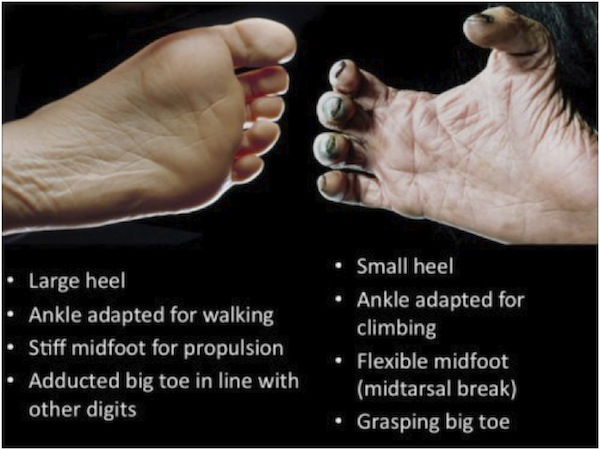
Ape feet (right) are suited for the arboreal lifestyle. Human feet (left) are well designed for walking upright on two legs. Evolutionists try to pass off the extinct ape Australopithecus sediba as a bipedal human ancestor. However, the more sediba fossils are studied, the clearer it becomes that the animal was suited for life as an ape. Humans are, on the other hand, designed for bipedal locomotion. Links between extinct apes like sediba and humans are evolutionary speculation. Learn how to answer evolutionary claims about human foot variations in “Flexi-feet: Did Some Humans Fail to Leave Them in the Trees?” and more about the marvelous design of the human body in “Organ Recital: A Parade of Presumed Design Flaws Devoid of Truth.” Image: DeSilva, The Upright Ape: Bipedalism and Human Origins, YouTube
God created all kinds of animals on Day Five and Day Six of Creation Week about 6,000 years ago. We have His Word on it! Then He created Adam, the first man, and brought many animals—“every beast of the field and every bird of the air” (Genesis 2:19)—to Adam to be named. Adam (unlike today’s evolutionists) could tell that he himself was not an animal. God then made the first woman—“a helper comparable to him” (Genesis 2:20)—whom Adam named Eve, meaning “the mother of all living.”
Thus began the story of the human race—with just two people specially created in God’s image. God made them in the same week He created all kinds of animals and plants as well as the earth and the universe itself (Genesis 1:14–19). And despite complaints by evolutionary naysayers who point out supposed human design-flaws in their misguided efforts to mock our Creator, the human body is exquisitely designed.
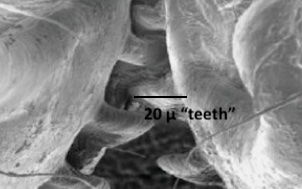
Beneath the belly of the leafhopper nymph, these tiny gears—which have teeth just 15 to 30 millionths of a meter tall—mesh to keep its hind legs synchronized for a powerful leap forward. Unlike man-made gear cogs, these teeth are curved for optimized function in one direction. The nymphs seem to outgrow their need for such “training wheels,” as adult leafhoppers do not have the gears. Image: M. Burrows and G. Sutton, doi:10.1126/science.1240284.1
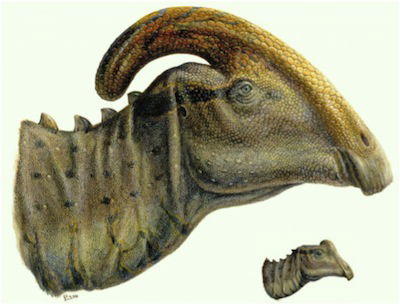
These scale drawings compare the size and shape of the crest on the adult and juvenile Parasaurolophus. Inside, the baby’s crest is completely filled with tubular passages connected to its airways, so the juvenile would have been able to produce a high-pitched version of the adult call. Image: Lukas Panzarin through Sci-News.com
God created all living things—by the power of His own words ( “And God said . . . ”)—to reproduce and vary within their created kinds. He required neither raw materials from outer space nor evolutionary time (Genesis 1:31–2:1). God reiterated this truth—that He had created all that exists in just six days—when He gave Moses the Ten Commandments, only a few thousand years later. Exodus 20:11 records God’s declaration: “For in six days the Lord made the heavens and the earth, the sea, and all that is in them, and rested the seventh day.”
Because Adam and Eve rebelled against their Creator, God’s perfect creation was cursed (Romans 8:20–22) with death, disease, bloodshed, and suffering. Thus, when we look to the animal kingdom to study God’s great designs, we also see how many have been affected by sin’s curse. The variations that occur within created kinds have included the development of many defense and attack structures, such as snake venom. Much of the fossil record is a stony memorial to billions of animals that died and were catastrophically buried about 4,300 years ago in the global Flood—God’s earth-shattering judgment (described in Genesis chapters 6–9) upon mankind’s pervasive wickedness.
A False Animal-Human Connection
Evolutionists this year tried to support a false human-animal connection by looking backward to “Sediba’s shadow” and by looking down—taking a close look at our feet in “Flexi-feet: Did Some Humans Fail to Leave Them in the Trees?” Evolutionists claim humans evolved from an ape-like ancestor that learned to walk upright and then progressed through a series of archaic transitions toward human-ness. Instead, genetic discoveries are consistent with the biblical history of humans descended from Noah’s family dispersing from the Tower of Babel to repopulate the world.2
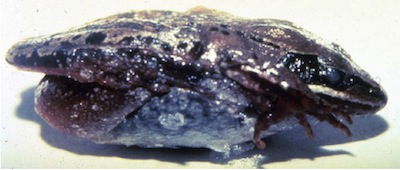
This “frogsicle” will go “thunk” if dropped. Two-thirds of the frog’s body water is frozen. The biochemistry of its body fluids is by ordinary standards quite out of whack, its organs are dehydrated, it is not breathing, and its heart is not beating. Yet it will be ready to mate within two days of the February thaw. Read more about the Alaskan wood frog’s icy response to the cold in “The Secret Lives of Frozen Frogs.” Image: Evelyn Dietz, news.sciencemag.org
God Designed Animals
Humans were created fully human and did not evolve from animals. Nevertheless, there is much we can learn from animals. From fleas to bees, genetic and biological discoveries in 2013 have unveiled many of God’s designs and variations that have occurred within the created kinds of animals in 6,000 years of earth’s history.
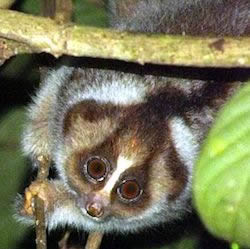
This recently discovered species of slow loris, Nycticebus kayan, is native to Borneo. Slow lorises as well as the slender loris are the only primates known to use venom. The poison in the loris bite can kill leeches, repel large predators, cause a severe allergic reaction in its enemies, and produce a necrotic, festering bite wound that heals very slowly. Check out the short video about this creature at www.bbc.co.uk.) Depletion of the apparently diet-derived toxin may contribute to failure in efforts to return captured lorises to the wild. Image credit: Wiki Commons
For the animal lovers among us, now seems a fitting time to recall just a few of animals that have helped us understand both God’s designs and the sin-cursed world in which we live. The irreducibly complex engineering marvel of the leafhopper nymph’s mechanical gears—the only known functional biological gears in the world—keep it hopping in sync as it bounds out of harm’s way. Dinosaur Joe, a baby parasaurolophus, had a head crest able to produce a high-pitched version of his parents’ call.
Animals Coping with a Sin-Cursed World
Coping with the environmental extremes in earth’s post-Flood world has been a challenge for many animals. Some, like mammoths, managed to cope with the cold but eventually became extinct. Others like the freeze-tolerant frogs discussed in “The Secret Lives of Frozen Frogs,” exhibit a complex array of adaptations tailored for harsh winters.
Venomous Variations
We opened and closed 2013 with venom. “The Many Faces of Loris” featured a venomous primate that takes advantage of toxic substances in its diet to produce a nasty nip that is discouraging to parasites and predators but not to persistent humans doing biological research. Venomous beasts don’t always win the day, however, and the variations that occur within God’s created kinds can produce powerful defenses, as demonstrated whenever a bark scorpion encounters a grasshopper mouse. Learn more about the possible medical applications of the mouse’s secret in “Scorpion Venom Is No Match for Mighty Mouse.”

A sting from this bark scorpion will not dissuade this grasshopper mouse from eating it. In fact, the mouse will hardly even feel the pain that would drive other animals away. The mouse’s analgesic secret—discovered this year—may help pharmacologists develop more effective pain-killers for people. Image: Matthew and Ashlee Rowe through “Grasshopper Mice Immune to Bark Scorpion Stings”
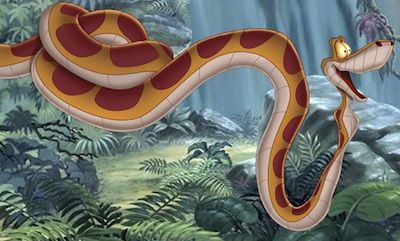
Kaa, created by author Rudyard Kipling and animated in Disney’s feature film The Jungle Book, is an Indian rock python. Kaa is the same species (Python molurus) as the Burmese python (Python molurus bivittatus) but is a somewhat lighter colored variety. How could this tube-shaped animal hope to digest a boy or the even larger panther Bagheera, as he threatens to do? Snakes are able to engulf and digest enormous prey, and the Burmese python is perhaps the most extreme example, even digesting prey equal to its own considerable body mass. Geneticists recently revealed how coordination of thousands of genes make the temporary anatomic and metabolic transformation to manage huge meals possible for these snakes. Having learned how the snake genome makes all this possible, they speculate that the evolution of snakes must have happened very fast to produce such prodigious physiologic potential. Instead they have shown how variations within the kinds of snakes God created make it possible to digest large meals. Image: “Kaa” on Disney Wiki
By year-end, the genomic underpinnings of king cobra venom had been discovered. Genetic research revealed that its venom is a collection of chemical variants of non-toxic substances already genetically encoded for use elsewhere in the deadly snake’s body. Indeed, efforts to elucidate the evolution of snakes, the evo-origin of venom, and even the influence of snakes on the evolution of the primate brain have instead shown only variations that occur within the kinds of animals God created in the beginning, not evolution of one kind of animal into another.
All Things Bright and Beautiful
Not all the great animal stories of 2013 dealt with defense and attack structures. In fact, some were reminders of the time before sin’s curse affected creation a time when all animals were vegetarians. For instance, “vegetarian piranhas” scraping vegetation off rocks pointed our attention to “pre-Fall perfection.” Highlighting another non-violent use for sharp teeth, we saw fruit-eating alligators picking kumquats for breakfast and smashing watermelons.
Evolutionary Psychology and Ape-Based Theology
Evolutionists tend to look for an evolutionary explanation for everything, even human morality, intelligence, and culture. Their quest—while failing to demonstrate their claims—has turned up some interesting discoveries. Therefore we have examined the supposed evolutionary implications of many animal behaviors and abilities, including dog yawns, peacock mate selection, and bird braininess.

This poodle’s owner just yawned. Dogs, like Kikumaru here, catch yawns from humans but not from other dogs. Evolutionary biologists want to know, “Does Your Dog Yawn Because He Cares?” Many of us personify our pets, seeing our own emotions in them. Some evolutionists draw spurious conclusions by projecting such personification into an imagined evolutionary past. Image: Toshikazu Hasegawa, news.sciencemag.org

Bonobos raised by humans make less effort to console their peers than bonobos raised by their own mothers. They also have more tantrums. Evolutionary primatologists believe the apparent similarity of such bonobo behavior to the emotional difficulties of institutionalized human orphans supports a naturalistic evolutionary origin for morality. What we believe about God, morality, and human nature has eternal consequences. Read more about bonobo empathy and why we should beware of ape-based theology in “Do Even-tempered Empathetic Bonobos Reflect Human Evolutionary History?” Image: Z. Clay through www.bbc.co.uk.
The apparent attempts of bonobos to “console” their unhappy friends have been cited as proof that human morality merely evolved. This proved to be an example of how personification projected into an imagined evolutionary past can gain ground even in peer-reviewed journals. We discussed the dangers of taking our theology from apes in “Do Even-tempered Empathetic Bonobos Reflect Human Evolutionary History?”
Missing Missing Links and Scrambled Stories
The search for missing links and transitional forms—while failing to demonstrate molecules-to-man evolution—has turned up some animal challenges to evolutionary tales. A remarkably advanced tyrannosaur showed up much too “soon” in the fossil record to fit into the evolutionary story of Tyrannosaurus rex. And when a fossilized grin “put a new face on the original jawed vertebrate . . . one of your oldest ancestors,”3 a fish found in Silurian rock—a location reminiscent of the fictional Silurians so familiar to Doctor Who TV fans—had experts in vertebrate evolution asking, “How did we get it so wrong?”
The latest answer to the long-running debate about the evolutionary origin of turtle shells—“Turtle in the Gap”—turned out to be nothing more than another fossilized variety of turtle considered in light of “Recapitulation Theory: Repackaged & Re-Applied.”
Fossils failed to document the transition from dinosaur legs to bird wing in a study demonstrating that bird wings appear abruptly in the fossil record without any evidence of the “classic major evolutionary transition”4 demanded by the dinosaurs-to-birds scenario.
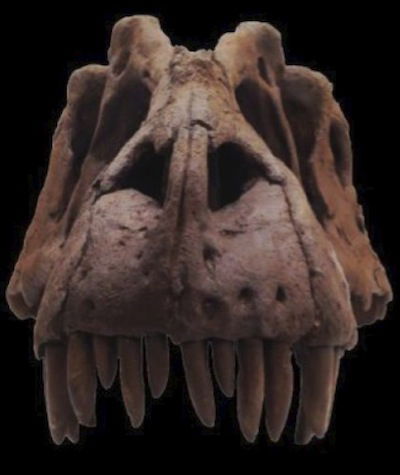
This is the reconstructed skull of Lythronax argestes, a newly named tyrannosaur species. Paleontologists think it would have been about 24 feet long and stood 8 feet tall at the hip, based on the size of the bones that were recovered. Found in southern Utah’s Grand Staircase-Escalante National Monument, conventional millions-of-years dating would place this so-called “king of gore” too early in the evolutionary timeline, which must be redrawn to make it fit. Image: Mark Loewen, NHMU through ScienceDaily.
Finally, claiming that the evolutionary mystery of flightless birds has been solved by proving that “good flippers don’t fly well,” researchers showed that flying birds and flightless birds are actually well-designed for their lifestyles.
Biblical Perspectives Guard Against Stumbling Blocks
Follow along with us in 2014 as we take a look at the latest discoveries that evolutionists will doubtless use (they suppose) to once and for all demonstrate that God could not have created. (Who knows what great divine designs they will discover in their efforts to keep a divine foot5 out of the door?) Meanwhile, please equip yourselves and your children to deal with the questions these claims raise in the minds of many. We wish you a great year of knowing and serving the Lord Jesus Christ even better than the year just past.
Further Reading
- The Bad News . . . and the Good News
- Doesn’t the Order of Fossils in the Rock Record Favor Long Ages?
- Should Sediba Sashay to the Throne for Oldest Human Evolutionary Ancestor?
- Organ Recital: A Parade of Presumed Design Flaws Devoid of Truth
- “The Search for the Historical Adam” and Population Genomics
- Vestigial Hiccups, Folding Fish-eyes, and Other Fables: Our Fishy Forebears . . . Again!
News to Know
Footnotes
- M. Burrows and G. Sutton, “Interacting Gears Synchronize Propulsive Leg Movements in a Jumping Insect,” Science 341 (13 September 2013): 1254–1256, doi:10.1126/science.1240284.
- Bible-believing Christians must be careful to avoid attaching biblical significance to evolutionary claims that borrow biblical terms. Molecular clock dates have the sound of precision and accuracy, but they are calibrated with evolutionary presuppositions. “Mitochondrial Eve” and “Y-chromosome Adam” concern populations and should not be confused with the biblical Adam and Eve just because of the popularity of tagging them with the names of our first parents.
- Quoted in Missing Link Found? Fossil Fish Face Flips Humanity’s “Evolutionary History” on Its Head.
- T. A. Dececchi and H. Larsson, “Body and Limb Size Dissociation at the Origin of Birds: Uncoupling Allometric Constraints Across a Macroevolutionary Transition,” Evolution 2741–2752 (September 2013), doi:10.1111/evo.12150. Quoted in Fossils Fail to Transition from Dinosaur Legs to Bird Wings.
- From a book review by the famous evolutionist Richard Lewontin. Lewontin wrote the following: “Our willingness to accept scientific claims that are against common sense is the key to an understanding of the real struggle between science and the supernatural. We take the side of science in spite of the patent absurdity of some of its constructs in spite of its failure to fulfill many of its extravagant promises of health and life, in spite of the tolerance of the scientific community for unsubstantiated just-so stories, because we have a prior commitment, a commitment to materialism. It is not that the methods and institutions of science somehow compel us to accept a material explanation of the phenomenal world, but on the contrary, that we are forced by our a priori adherence to material causes to create an apparatus of investigation and a set of concepts that produce material explanations, no matter how mystifying to the uninitiated. Moreover, that materialism is absolute, for we cannot allow a Divine Foot in the door.” Richard Lewontin (Harvard University geneticist), “Billions & Billions of Demons,” New York Times Book Reviews (9 Jan. 1997), p. 31 (italics in the original). The review is of Carl Sagan’s book, The Demon-Haunted World: Science as a Candle in the Dark (Random House, 1997).
Recommended Resources

Answers in Genesis is an apologetics ministry, dedicated to helping Christians defend their faith and proclaim the good news of Jesus Christ.
- Customer Service 800.778.3390
- Available Monday–Friday | 9 AM–5 PM ET
- © 2025 Answers in Genesis

